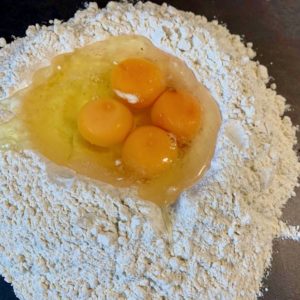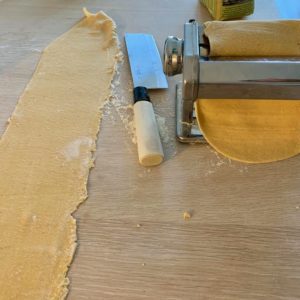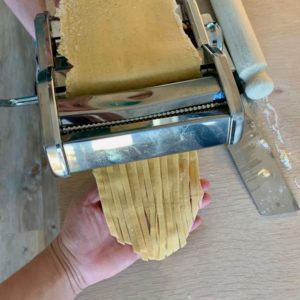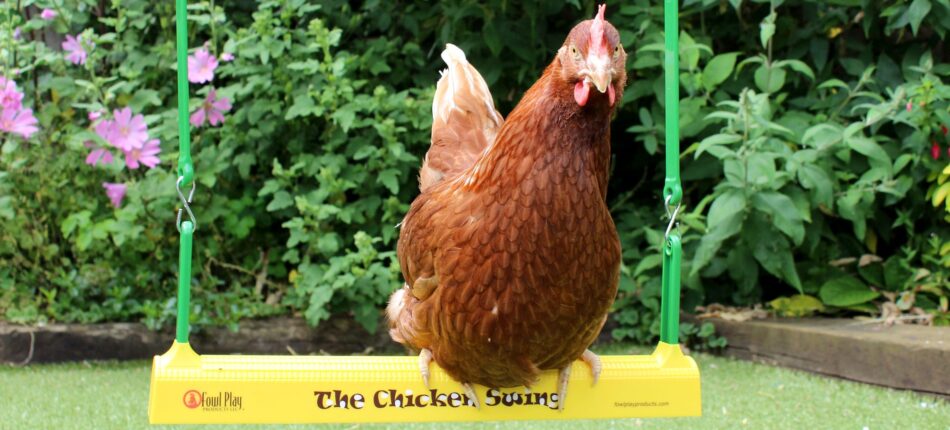
Roosting high up in trees comes natural to chickens, as that is one of the safest places to rest if you’re a chicken in the wild. And doing so on gently moving, or even swinging, branches makes you an even more difficult target for predators. So instinctively your birds should be happy to jump straight up on their Chicken Swing!
With that being said, chickens are vulnerable and clever creatures, which means that they can be wary of new things. They don’t like being the first to try something, so if you’ve got your flock a new toy and are disappointed they don’t seem particularly interested in it, you might have to help them take the leap!
Setting up The Chicken Swing
The Chicken Swing is cleverly designed to make it as easy as possible for chickens of all ages to use it. The base of the swing has a texture resembling a corncob, which makes it more grippable than a smooth plastic surface.
Make sure you place the swing free from any obstructions such as walls, mesh or other things on the run. Choose a sheltered spot under cover so the hens can do their swinging no matter the weather!
Eventually you ideally want the Chicken Swing to sit above the chickens’ heads, so that they will be able to swing without the risk of bumping into one of their friends. It’s no problem for a chicken to jump up a few feet, but to make it as easy as possible in the beginning, start with the swing close to the ground. The Chicken Swing is lightweight enough that if it were to hit one of your hens, it won’t hurt them.
You won’t need to train all your chickens to get on the swing. They are flock animals, so if you get one of them to show the others how it’s done, there’s a high chance the others will follow shortly!
Letting your chickens have a go
So choose your most adventurous chicken and place her on the swing, which at this stage should be hanging very low to the ground. Give her something delicious straight away, so that she associates the swing with yummy treats. Do this a few times until you feel she’s comfortable perching on the swing. At this point, push the swing slightly to get it moving. Reward the chicken every time she swings towards you. Push a bit more every time you’re trying, and start lifting the Chicken Swing higher and higher above the ground.
If the chicken at any point seems stressed or anxious, stop the training, let her down and go back to basics. It’s important that she only has good feelings associated with the swing!
It’s not guaranteed that all chickens will warm to the swing, it’s just a fact you have to accept. Young chickens are in general more likely to take risks and learn new things, but personality plays a big part, so you’re not automatically going to succeed just because you’re introducing the swing to chicks. However most chicken will, after some persuasion, absolutely love swinging, and it’s worth a bit of work when you see your girls queueing up for their go!
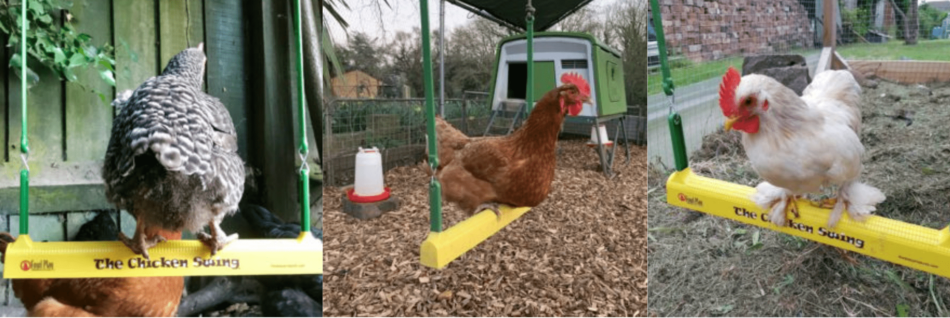
This entry was posted in Chickens on May 29th, 2020 by linnearask
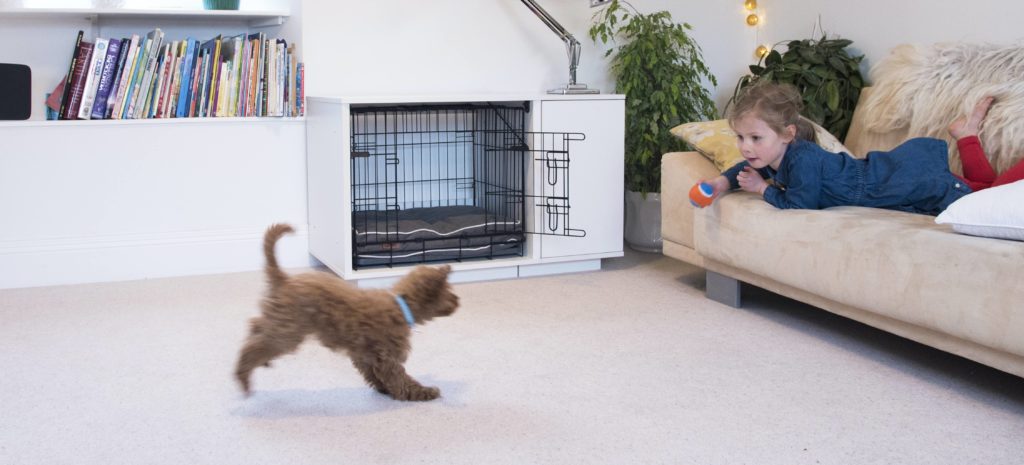
Having a crate for your puppy or dog has many advantages. It creates a space that is more than just a bed on the floor, a place the dog can return to when he or she gets tired that they know is just theirs. This is perfect for those moments when a small puppy feels a bit overwhelmed with the hustle and bustle of the house and would just like a moment of rest. A crate will also keep young dogs safe if you need to pop out someplace where puppies are not allowed. Additionally, crating leads to better sleep, is great for puppy training, and allows the dog to be more independent of its owner. And of course most importantly, most dogs absolutely love it!
Omlet has two great solutions for those who are looking for a crate for their existing dog, or the new puppy they’re expecting: the Fido Studio and the Fido Nook. Both come in two sizes to fit most dog breeds, and with the option of a wardrobe to store all of your dog’s things. The wardrobe can be further organised with shelves, hooks and a clothes rail, and a fitted mirror so your pup can make sure their outfit looks pawfect before hitting the park!
Both the Fido Nook and Fido Studio are stylish, modern crate solutions, but what is the difference between them? Here are the main things to note when choosing the one that best fit your needs:
- With the Studio, the crate is a completely integrated part of the piece, whereas it can be removed on the Nook. The easy release mechanism on the Nook makes it possible to lock the crate in place when you’re using it, and remove it when your puppy is fully grown.
- The Nook does not only fit in seamlessly with your home interior, but the possibility of unlocking and removing the crate means you can take it in the car to keep your dog safe during travel, or if you’re spending the night somewhere else.
- Both the Studio and the Nook come in a stylish white that will look great in all interiors. The Studio is also available in walnut.
- As the Fido Nook you can only open the door to the crate on the front. If you choose the Fido Studio however, the dog can access the crate at either the front or the side. This is useful if you want to place the Fido Studio in a narrow space.
- If you decide to remove the crate from the Nook when your dog is fully trained and you feel he or she no longer needs it, the Nook will still offer a secluded spot for your dog’s bed.
- Without the crate on the Nook, you can further customise the unit with these luxurious curtains. This will create a cosy barrier between the dog and the world outside, which will provide them with some extra, highly appreciated, privacy.
- Although the two are quite similar, they do look slightly different, and perhaps you just prefer one over the other. That’s okay, you don’t have to explain yourself – we won’t judge!
Whether you decide to go for a Studio or a Nook, we’re absolutely sure your dog will appreciate a place in the home that is just theirs, and that you will love the look and feel of Omlet’s dog products, as well as the opportunity to store all your dog’s things in the integrated wardrobe!

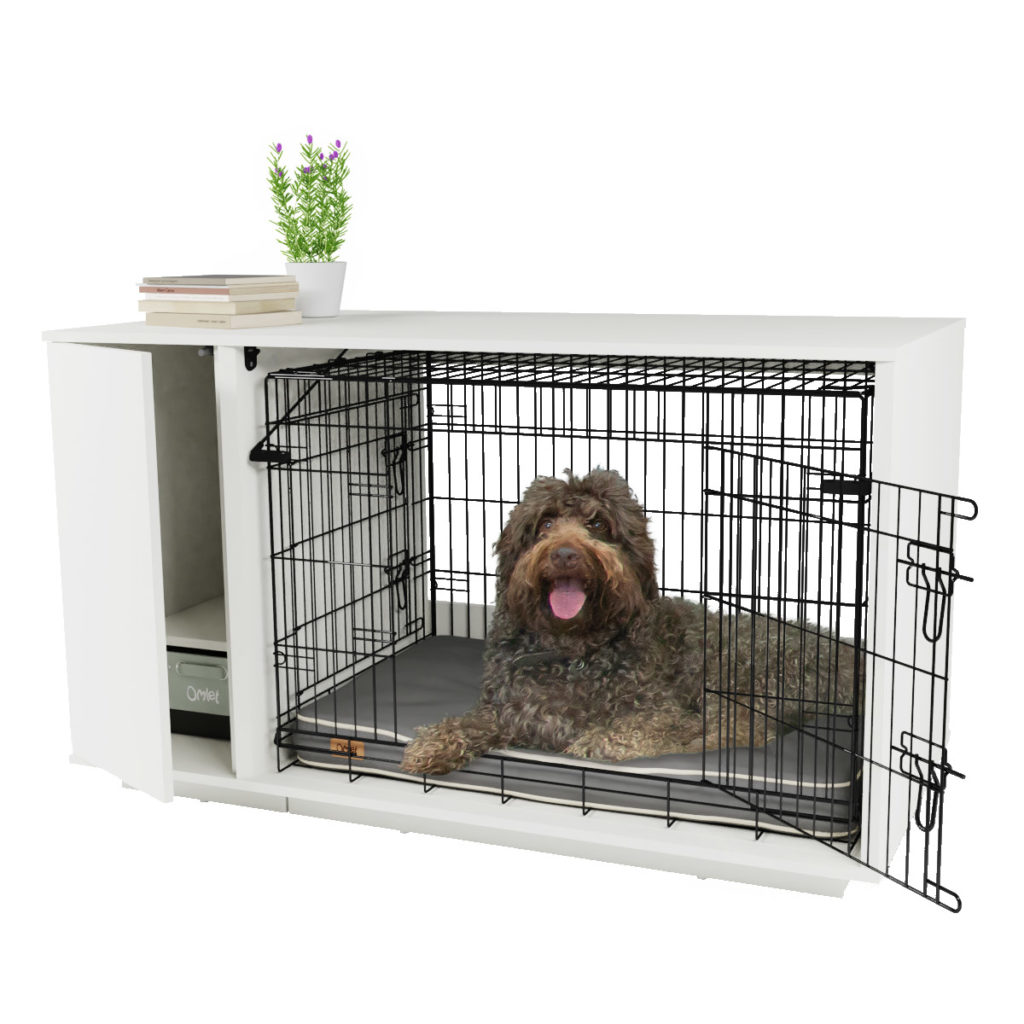
This entry was posted in Dogs on May 26th, 2020 by linnearask
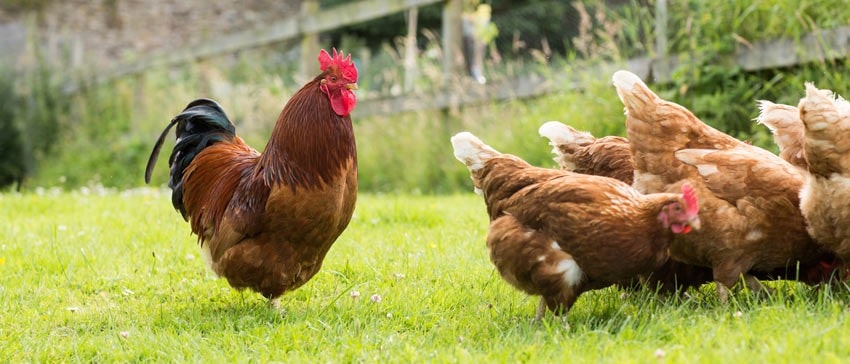
Most chicken keepers limit their attentions to hens and eggs. Roosters – or cockerels, as they are often called in the UK (and definitely not to be confused with roasters!) – are simply not on their tick list. After all, roosters are territorial, keen to defend their flock of hens, and famously noisy first thing in the morning.
But they are also beautiful birds, and if you intend hatching your own chicken eggs, your hens will certainly need the attentions of a rooster.
There are several cockadoodle-dos and cockadoodle-don’ts to consider if you are thinking of adding a rooster to your flock.
First, the good stuff
Cockerels look fantastic as they swagger across their territory. Their huge combs and wattles quiver like jelly, their pointy rear-end feathers and ‘mane’ of spiky neck feathers are wonderfully showy, and their posture suggests someone who has just strutted onto the dancefloor to show off some amazing moves.
But it’s not all about beauty. Roosters always have an eye out for danger, and will fight off any intruder they think they can tackle. The bird is not silly enough to attack dogs or cats, but it will make it clear to them that they are not welcome, through body language and alarm calls. This gives the hens time to flee for shelter, and the rooster will beat the retreat too, if things start to look too dangerous.
A rooster will add harmony to a hen flock, making sure none of his birds are bullied, and keeping everything in order, a bit like a hands-off, benign sheepdog.
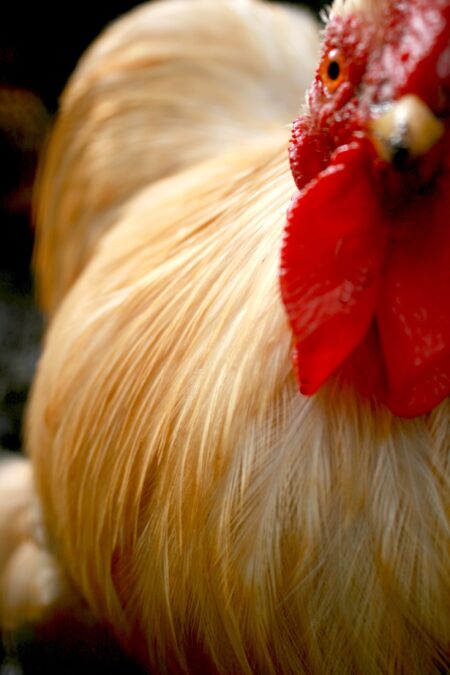
If you want to hatch chicks, hiring the services of a rooster is the only way forward. Fertilised eggs are still edible, as long as you collect the eggs on a daily basis. Any fertilised egg taken away from the warmth of a broody hen will not develop into a chick.
And the downsides?
If you live in a town or village, noise might be an issue with the neighbours. In many places in the USA, roosters are banned for this reason. However, if your bylaws don’t place an outright ban on male chickens, you’ll have the law on your side. But what about those irate neighbours?
The irony is that people who keep roosters – and many others besides – love the sound of early morning cock-crow. I raise my hand, as the author of this post, and admit to loving the sound of a rooster at daybreak – and I live in a village with half a dozen cockerels battling it out first thing in the morning. It’s a much better sound than car engines and slamming doors as people prepare for the working day. If people can live with the sound of road, rail and air traffic, surely they can get used to the wonderful sound of a full-throated rooster?
Sadly not, in many cases, and a crowing cockerel can be the subject of arguments and recriminations. So, so if you have nearby neighbours, it’s an issue you can’t ignore. Start off by speaking to everyone who live near enough that they will hear a cockerel crowing in the morning and see how they feel about the idea. You never know, they might be really excited about the prospect of a new alarm clock!
With that being said though it’s worth noting that roosters naturally crow, and if you (or your neighbours) can’t stand being woken up at the crack of dawn, you might be better off sticking to hens.
The rooster is not just a chicken version of a sheepdog, he’s a guard dog too. At the sight of any intruder, he’ll let you know. This is just the kind of vigilance you’d expect from a bird once declared to be the messenger of the sun god. And that’s a lovely image – he’s not crowing to annoy anyone, he’s crowing to announce the arrival of the life-giving sun. Who could say no to that?
This entry was posted in Chickens on May 23rd, 2020 by linnearask
By becoming an Omlet affiliate you could earn 5% commission from every sale you generate from your website, blog, or social media account.
You will put a personal link to our website somewhere on your platform. If someone clicks on the link and goes on to place an order, you will earn commission!
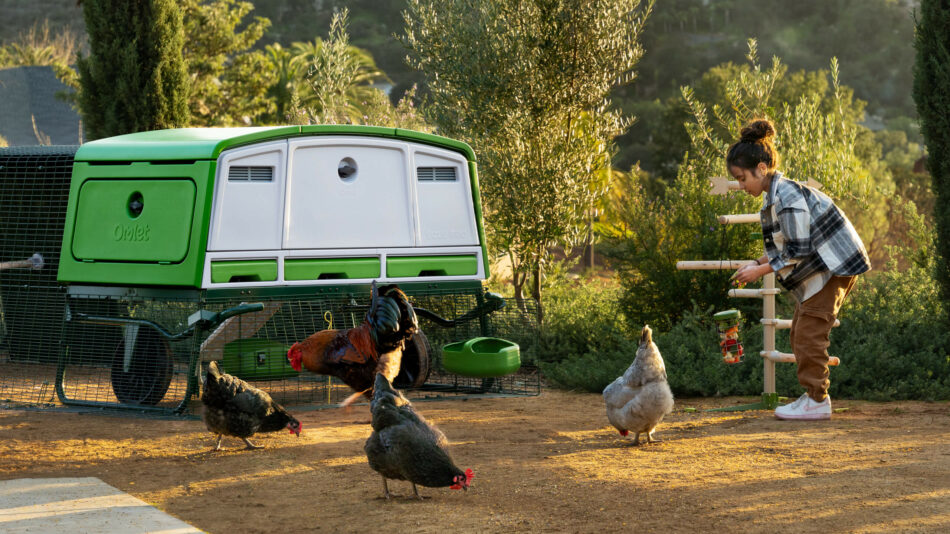
What are the benefits of the Omlet Affiliate Programme?
- First and foremost, you can earn money by turning your website, blog or email marketing campaigns into an income.
- There are no start-up or running costs, you can start earning straight away.
- You can promote our products without having to carry any inventory, so there is no risk for you.
- All customer communications, shipping and returns are handled by Omlet and our in-house Customer Service Team.
- You can choose which products you advertise to your followers or customers, and how you would like to promote them. You can change links according to season or change a link for a banner whenever you like.
Why advertise Omlet products?
Omlet products are instantly recognisable and unlike anything else on the market in terms of design and quality. We actively work on and invest in brand and product awareness, so that when customers see Omlet products on your platform, it is likely that they have already heard of the brand.
We have a team of product designers who are constantly working on new products, so there will always be something exciting to show your customers or followers.
How do I get started?
We now use Awin to host our affiliate program. Create an Awin Account here and wait to be accepted by the platform; this can take a few days. Once accepted, navigate to ‘Advertisers,’ then ‘Join Programmes,’ and search for Omlet, or you can use our ID 76702. Alternatively, use this link to view our profile and join the program.
It may take a few days for us to accept you onto our program, but in the meantime you can start familiarising yourself with the Awin interface and thinking about which Omlet products you would like to promote.
As well as creating links, you will have access to a Creative Library full of banners and images that you are free to use.
How do I create links?
Once we have accepted you onto the program, you will be able to start creating your tracked links to share with your audience.
To do this follow the steps below:
- Go to ‘Toolbox’ and then ‘Link Builder.’
- Select Omlet from the ‘Advertiser’ dropdown.
- Enter the URL from the Omlet website page you would like to direct traffic to into ‘Destination URL.’
- Click ‘Generate link.’
- Scroll down to see your generated link.
- Copy and paste the link into your website to complete the process.
- If you would like a link for social media, click ‘Shorten Link’ to create a concise link that you can put on Facebook/Instagram etc or into a LinkTree.
- Copy the link and paste it onto the social media website of your choice.
How does Awin know which orders come from me?
The link you create through Awin contains information about your website. When someone clicks this link from your site, Awin knows that the person has come from you. Even if they leave the Omlet website and come back again they will still know that the customer originally came from you. This works for up to 60 days from the original click.
You will receive your affiliate commission on anything that the customer purchases on the Omlet website within that 60 day period. The customer doesn’t have to buy the product you are linking to for you to get commission, Awin will be able to keep track of your publisher ID as the customer moves around the website. This means that if they clicked a link about the Autodoor on your site and end up buying an Eglu Go Hutch you will still get your affiliate commission.
You can create as many links as you like to as many pages as you like.
The system will track link clicks, banner views, orders, and commission on your Awin account.
How do I get paid commission?
When you have earned commission Awin will send the money to the bank account that you have connected to your Awin profile. Please note that the commission of 5% is calculated on the order value excl. tax, and no commission will be paid on delivery costs.
Do I need a particular type of website to participate?
No, you can add any type of website, blog or social media account as long as it does not host content that is in any way unlawful, harmful, threatening, obscene, harassing, discriminatory, defamatory or otherwise objectionable; facilitates or promotes violence, terrorism, or any other criminal activity; is sexually explicit; or infringes or assists or encourages the infringement of any intellectual property rights belonging to any party.
Get Started link needs to link to our Awin Profile

This entry was posted in Pets on May 22nd, 2020 by linnearask

Watch a cat stalking through the grass or simply relaxing in the sunshine, and it’s clear that they love being outside. If you live in the countryside, this isn’t much of an issue, and all country cats mix and match the great outdoors and the great indoors. In towns, however, owners may be less keen to let their cat spend a night on the tiles.
Town cats have shorter lifespans than country cats, on average. This is not due to the benefits of fresh air – it’s simply because most premature deaths in the cat population are caused by road accidents, and a town the cat has far more chances of quickly shedding its nine lives.
Why do cats like being outdoors?
Do you like spending time in the sunshine, with the fresh air in your lungs and a gentle breeze on your face? Cats are exactly the same. Like you, they get a buzz from life beyond the four walls. They are stimulated by movement, sounds and scents, and even the humblest garden has these in abundance. Cats will investigate whatever the world has to offer, and this gives them both mental and physical stimulation, a combination that results in a happy and healthy cat.
Research has shown that certain sounds, including the squeaks of rodents and the twittering of birds, is particularly stimulating for cats. They find these things satisfying and engaging on an instinctive level, and all animals need to keep their instincts happy.
If given the chance, cats will make full use of the possibilities of life in the fresh air – not just the immediate vicinity, but the much wider local area, sometimes prowling a territory with a radius of one mile from their home. They will form all kinds of relationships in this territory, some friendly and some not, but all part of the rich tapestry of cat life.
What this means is that access to the outdoors is a great stress reliever, giving a cat many of the things it needs in order to stay alert and content, and to allow it to chill in its natural habitat.
However, owners who want to keep their pets indoors should not be put off by this. They can still provide their pet with most of the benefits of the outdoor life.
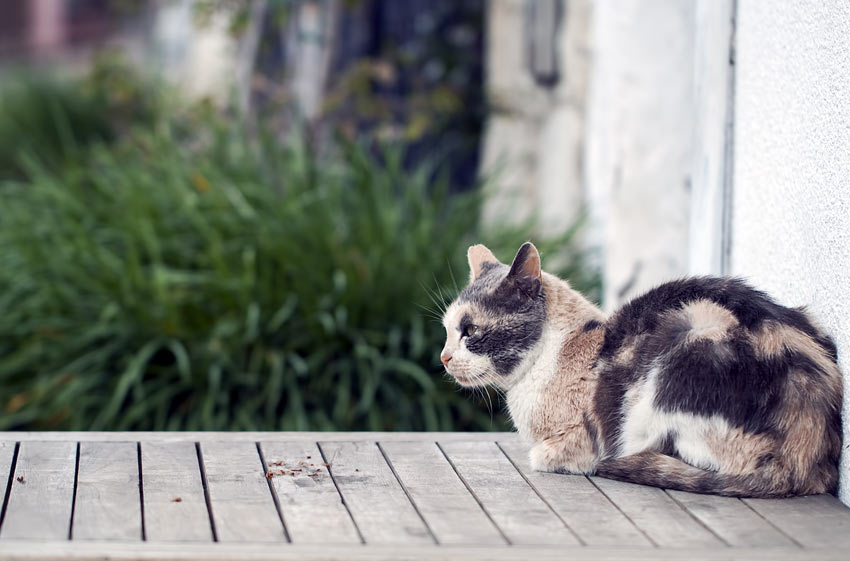 How to bring the outdoors indoors
How to bring the outdoors indoors
Breed – and therefore personality – plays a big part in a cat’s contentment. Some breeds – including the Burmese, the Siamese, the Korat, the Oriental and the Abyssinian – need the outdoors in the same way as a piano player needs a piano, and they will not be happy if denied access to nature. Others – including the Persian, the Russian Blue and the Ragdoll – seem to have been bred for a life on the sofa, and will not miss being outdoors one little bit. Most crossbreed cats like to enjoy the best of both worlds, so if your cat is going to live indoors, you will need to make the domestic space a bit more ‘wild’.
Providing stimulation with toys, including ones filled with catnip, is half the battle. You should also open your windows wide enough to let the fresh air and the scents and sounds indoors, without giving an escape route for the cat. Failing that, opening the door to the garden while closing off the inner doors will allow the fresh air to circulate.
If space allows, a cat run is a great option. This can be linked to the house via a cat flap on the door, allowing your pet to spend as much time outdoors as it wants. If the cat run is not connected to the house, you can let the cat spend time on the run while you’re out in the garden as well. Or, if you start early, you may be able to train your cat to walk on a lead. This needs careful planning, though, as avoiding dogs out on their walks is an important detail!
Even if you live in a flat it’s possible to allow your cat some fresh air, providing you have a balcony. Omlet’s Cat Balcony Enclosure fits most balconies, and will give your cat a safe space to feel the wind in their fur.
The main takeaways from this are that cats need fresh air, and all the things it represents. But at the same time, town cats who are happy with a life on the sofa can enjoy most of the fun and stimulation of the outdoors by staying indoors.
This entry was posted in Cats on May 21st, 2020 by linnearask
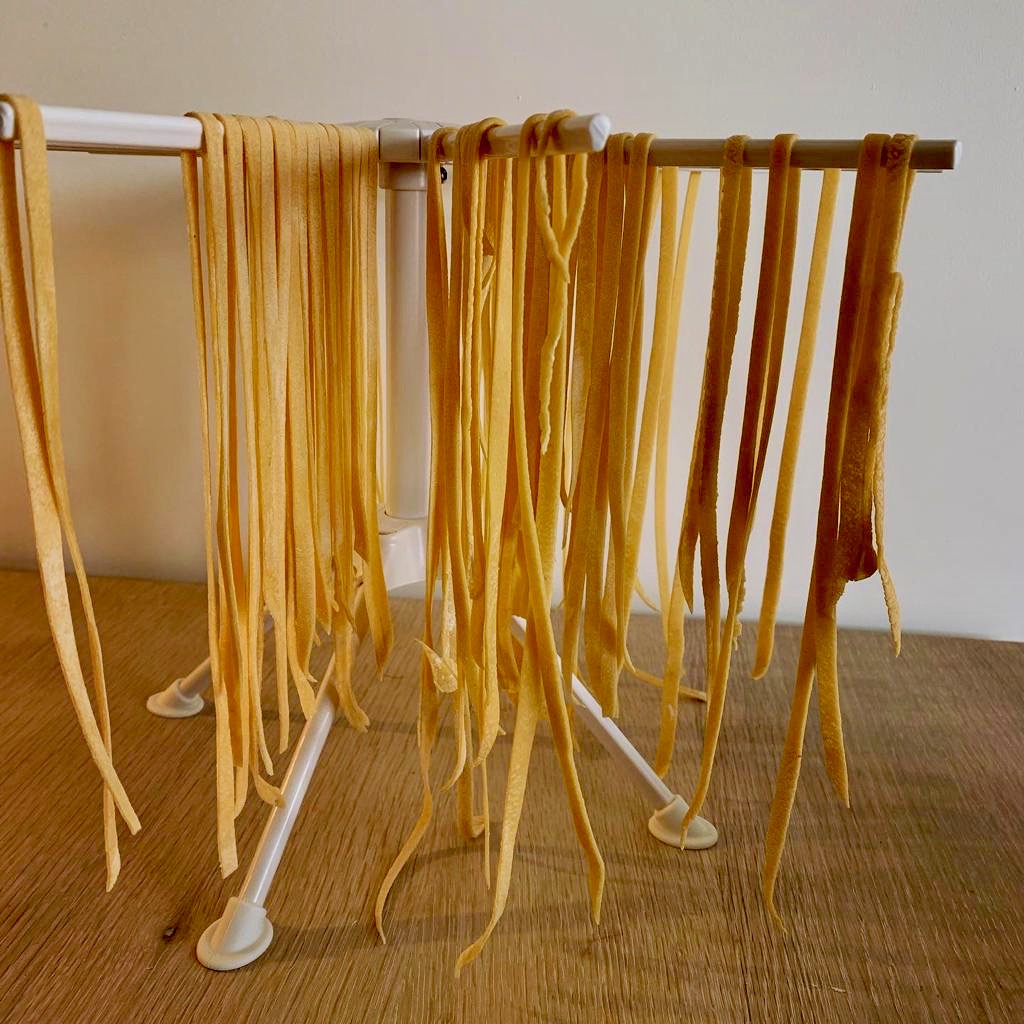
Ingredients
Tipo 00 Flour
Eggs
Salt
Homemade pasta is one of the easiest recipes to remember as it’s a 1:100 ratio. For every person you’re cooking for you’ll need 1 egg and 100g of pasta flour per serving, plus just a little bit of salt for seasoning – simple! This is how we at Omlet make it:
? Start by weighing out your flour and then tip it onto a clean surface so it forms a mound, sprinkle with a bit of salt, then make a large well in the middle of the mound and crack your eggs into it.
? With a fork start lightly whisking the eggs in the middle, slowly bringing the flour at the edges into the mix, keep going until you’ve got the majority of the flour mixed in. You may need to use your hands to work it in towards the end. Once the mixture is all together in a ball, start kneading the dough. It will feel quite rough and grainy to start with but as you work the dough more it should start to smooth out.
? Knead until the dough is elastic and stretchy. Be careful not to over knead it as your pasta will become tough and chewy. Once you’re done kneading, cover or wrap your dough in a bowl or a beeswax wrap and then place in the fridge for half an hour.
? Once chilled, bring your dough out. Depending on how much you’ve made you may need to split it into more manageable chunks.
? Start rolling out a ball of your dough with a rolling pin and then with your pasta maker. Roll the dough through the machine on the widest setting, once through fold the dough in half and repeat. Then feed the dough through on a medium thickness and fold in half and feed it through again. Then move onto the thinnest setting and feed your dough through this setting twice, no need to fold it over this time. Your dough should be in a long lasagne style sheet, and thin enough that you can almost see your hand through it.
? Then turn your attention to the linguine and tagliatelle accessory on the pasta machine. You can use either of these for this type of pasta, it will just depend what sauce you’re making and your personal preference. We used the tagliatelle cutter for this batch and it came out great!
? Once you have fed your pasta through the chosen cutter, then hang it on a drying rack, or you could use a clothes airer for about half an hour. You don’t want the pasta to dry out too much. When it’s ready either boil it in salted water for about 3 mins if you’re ready to eat, or place in a Tupperware in the fridge or freezer ready for when you want to use it.
This entry was posted in Recipes on May 19th, 2020 by linnearask
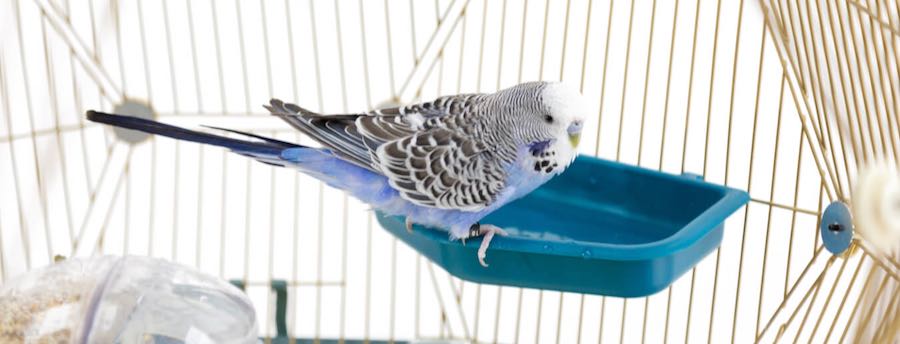
The starting point for all budgie tricks is trust, and the key to success is treats! Once a budgie has been hand-tamed and is happy to perch on your finger outside the cage, you can take it a step further and introduce some fun challenges. Make sure you have a sprig of millet or your pet’s favourite vegetable snack handy!
Snakes and Ladders
For this, you need a small raised platform, with a ladder leading on one side and a slide on the other.
The ‘ladder’ part of the trick is simple: place the budgie at the foot of the ladder, and offer the treat at the top. As the bird climbs up, use a command such as ‘Up the ladder!’ After a while, you will be able to place the budgie further from the foot of the ladder.
For the ‘snakes’ part of the trick, the budgie will scoot down the slide, and once again the millet or other treat is the key. Place it at the foot of the slide, and be patient. It’s very likely that, being such a smart bird, the budgie will fly to the treat without using the slide. If this happens, hide the treat, and start again.
The budgie will soon realise that the slide is the key to the treat. Once the bird is on the slide, say ‘Down the snake!’ You can then extend the ladder and the ‘snake’, if you wish.
Budgie Football
If you put a table tennis ball in your budgie’s cage, the bird will soon be playing with it, ‘dribbling’ the ball with its beak. Outside the cage, this can be turned into a human-versus-budgie football game. Gently roll the ball towards the budgie, and the bird will instinctively ‘save’ the ball. Include a goal mouth, and your budgie is transformed into a goalkeeper.
Set up another goal mouth a metre away from the budgie, and see if the budgie manages to score a goal as it taps the ball forward with its beak. Once the ball is between the goalposts, say something like ‘Goal!’, and offer a treat. The bird will soon learn to hone its beak-dribbling skills in order to score those treats!
The Great Escape
The aim here is to get your budgie to negotiate a short tunnel. It won’t be tunnelling its way to freedom, though, just to a tasty treat!
To begin with, use a piece of cardboard with a large hole cut into it, or a large plastic ring. Call the budgie, offering a treat on the other side of the hole. As the bird hops through, speak your chosen command words – something like ‘Let’s tunnel!’ Once the trick is going well, swap the hole for small sections of plastic or cardboard pipe, with a narrower hole/tunnel as time passes. Eventually, you will be able to call your budgie to make his Great Escape through something with the thickness and length of a kitchen towel tube.
Fetch
This one takes a little time to get right, but once again the budgie’s intelligence wins through in the end. The goal here is to teach your bird to pick up an object, bring it to you, and drop it into your hand.
To begin with, get the budgie to perch on your hand, and offer a shiny object such as a button or paperclip. When the budgie takes it in its beak, say ‘Fetch!’ When it drops the object, say ‘Drop it!’, and if it lands in your hand, offer a treat.
Once this has been mastered, place the object away from your hand, and say ‘Fetch!’ when the budgie picks it up. Bring your hand close, ready to catch the object when it falls. Over time, this will develop into a routine in which the budgie picks up an object, runs back with it, and places it in your hand for a treat.
The thing that all these tricks have in common is that the budgie will love performing them. If they don’t want to take part, they won’t, simple as that. This means there’s no pressure, no forcing the issue. It’s just fun all the way, for budgie and owner alike. Trust and treats – that’s the key!
This entry was posted in Budgies on May 16th, 2020 by linnearask

If you keep chickens, you already know what a happy, healthy hen looks like. If anything changes, it’s a sign that all is not well in the henhouse.
The commonest problems are not due to diseases or parasites, but stress. If the henhouse is overcrowded, dirty, or too hot, or if the birds are feeling harassed, they will become stressed. The symptoms include egg-eating, aggression to their neighbours, loose droppings, lethargy, and a sudden interruption to their egg-laying.
The cause should be obvious enough, once you stop to look. Too many birds in one house? No shelter from direct sunlight? No room to exercise? Nothing but wet mud? These things can be sorted out by rearranging the hens’ environment, extending the run, and getting a bigger hen coop. Check the hens’ diet, too – are you feeding them a good, fortified chicken feed, supplemented with some corn? Poor nutrition is a gateway to other health issues, as it weakens the birds’ immune systems.
Infectious Bronchitis – The Commonest Chicken Disease
There are many diseases that can afflict chickens, but thankfully most of them are uncommon. Anecdotal evidence shows that Infectious Bronchitis is the one that small-scale backyard hen keepers are most likely to encounter.
Hens suffering from this ailment will have a quiet, rasping, wheezing cough, sneeze or snore. The first signs of the problem are usually a loss of interest in food. As the disease takes hold, the hen will develop a ‘runny nose’, with discharge from the nostrils and eyes.
The bronchitis is caused by an airborne virus, and the best remedy is vaccination of the flock. Any infected birds should be isolated and kept somewhere dry and warm, making sure they eat and drink well. Some will die, but most pull through.
Note: the symptoms described here are also associated with other diseases, including Infectious Sinusitis, Newcastle Disease, and the deadly Aspergillosis, Pullorum and Bird Flu. The Omlet Chicken Guide has more details.
Bumblefoot – The Commonest Chicken Injury
A leg or foot wound that becomes infected can result in Bumblefoot. The wound will not always be obvious, but the biggest clue is a limp, or the tendency to stand for a long time on one leg while the other hens are scratching and pecking for food.
After a few days, the limb will swell, at which point you need to act fast. Taking the bird to a vet is the best bet, as the wound will need thoroughly cleaning, and minor surgery may be involved if the problem is severe. Untreated hens can die.
Not all limps are the result of Bumblefoot, though. Hens sometimes land awkwardly after the chicken version of flying. Broken toes and legs are quite common too, and these will require a splint. But if there is no visible surface wound, Bumblefoot is unlikely to set in.
So, look out for the limp – that’s your first clue that all is not well.
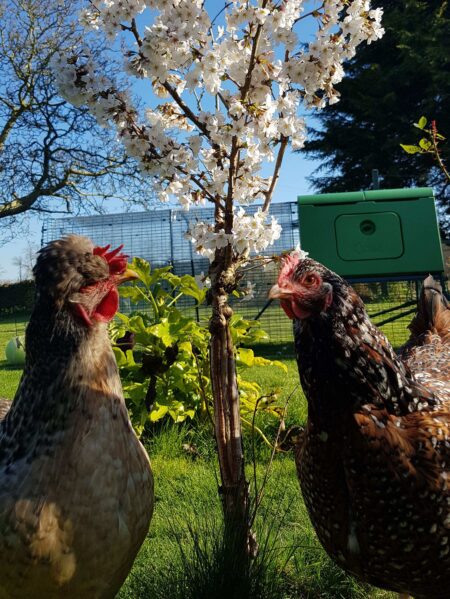
Common Chicken Mites
Chicken parasites are common, but not usually life-threatening. The commonest ones are the mites, of which there are several species.
Red Mite, or Chicken Mite – These nasties hide away in the henhouse, in corners, under perches and elsewhere. Anti-mite powders and liquids can be applied to the coop, and keeping things super-clean at all times will discourage the tiny red bloodsuckers.
Northern Fowl Mite – these are a bit bigger than red mites, and live on the birds rather than just dropping in for a quick bite. Remedies are available, and need to be applied to the bird itself.
Scaly Leg Mite – This variety causes a hen’s legs to become rough, sore and weepy. Antibacterial scaly-leg treatments are the only way to tackle the problem; although rubbing in a little Vaseline can ease the discomfort.
Depluming Mite – This variety burrows into the feather shafts, causing swelling and producing a discharge on which the mites feed. The hens will then begin plucking their own feathers to relieve the discomfort. The mites spread quickly, so the whole flock and henhouse will need treating.
Quick action is the best way of tackling these ailments. Each morning, carry out a quick visual health check. Any of the following should be taken as a warning sign:
- Dirty or messy feathers
- Hunched-up posture
- Lethargy
- Evidence of parasites
- Unhealthy-looking poo
- Sneezing, wheezing, coughing
- No appetite
- No eggs
If you have cause for concern, check out Omlet’s chicken health guide, and call the vet for advice.
This entry was posted in Chickens on May 13th, 2020 by linnearask
Azawakh
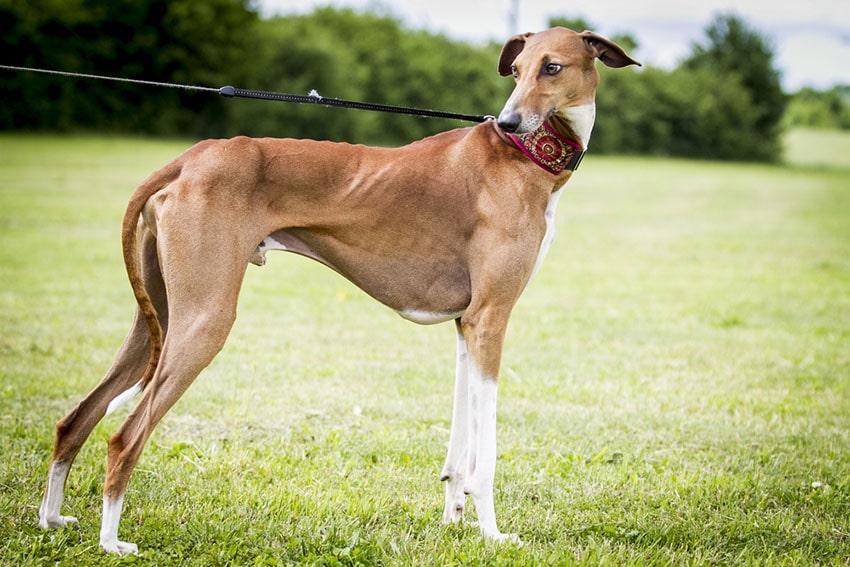
The Azawakh originates from the Saleh area south of Sahara, where it’s still used by nomadic people to guard herds of sheep and goats from predators and enemies. It has also previously been used to hunt gazelle and hare across the arid desert lands.
The Azawakh is a very lean and large sight dog with long legs, and the muscles and bones are clearly visible through the thin skin.
It’s a loyal family dog that forms strong connections to their owners, and must get used to being by themselves early on to minimise the risk of separation anxiety. The breed needs to run freely, so make sure they can do so in a safe area. The hunting instinct can be strong, but they are intelligent and relatively easy to train, so it’s possible to take them from walks off the lead.
Catahoula Leopard Dog
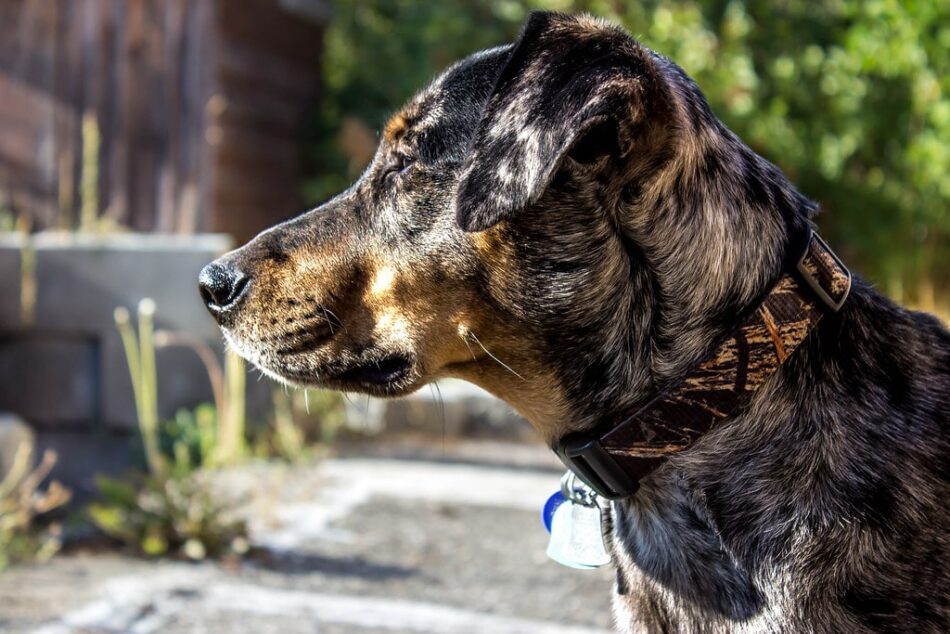
The Catahoula Leopard Dog was originally bred in the state of Louisiana, and was initially used to hunt large game, and later feral pigs in the swaps. It’s still used as a working dog with several purposes, including herding, as it’s known for its agility, intelligence and strength.
It’s a medium sized dog with a short coat that is normally recognised for its many varied coats, eye colours and patterns. Catahoula Leopard Dogs can make great pets as long as they get enough stimulation. It’s also important to train and socialise them early, as they run the risk of getting territorial and overly protective otherwise.
Caucasian Ovcharka / Caucasian Shepherd Dog
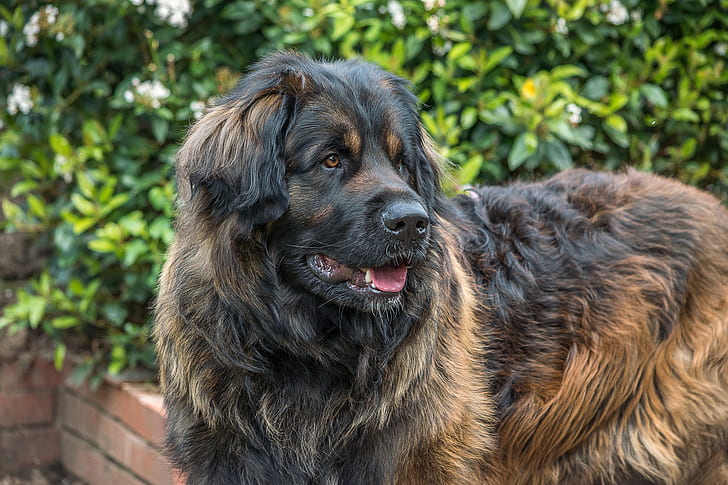
As the name suggests, this giant dog breed originates from the Caucasus, an area between the Black Sea and Caspian Sea, where it was first used to herd livestock.
It’s an extremely independent, fearless and intelligent dog that can get very territorial and protective, so requires an experienced owner that can give them consistent handling and accurate socialisation throughout their lives. This will counteract potential aggressive behaviour, mainly towards other dogs.
Caucasian Ovcharkas require plenty of both mental and physical stimulation. When not working, the dog will enjoy sleeping the day away, so it’s important to prevent the high risk of obesity by going to plenty of walks and playing fun retrieving games.
Schipperke

Schipperke means small herding dog in Flemish, which is where the dog breed was first seen. It’s also got a history as a guard dog and ratter on the Dutch and Belgian canal boats. Today the breed is mainly kept as a pet, but it still makes a great guard dog, as you’ll struggle to find a more loyal companion.
As the Schipperke was bred to work, the breed will need to be kept stimulated and active to prevent destructive behaviour, but it’s relatively easy as they will be happy with most things as long as they are with their owner!
Berger Picard
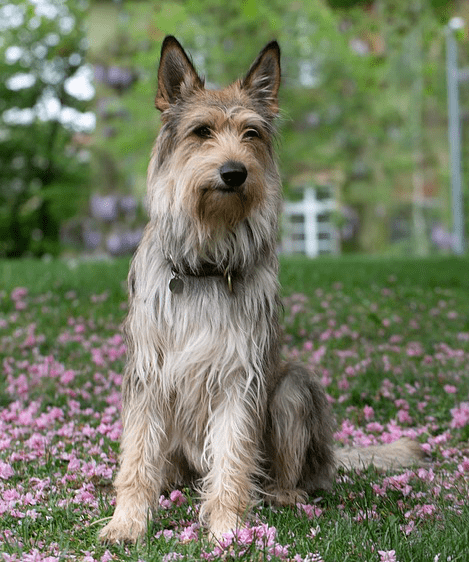
The Berger Picard is easily recognisable thanks to the large pointy ears, the wavy brindle coat and the hooked tail. The name comes from the breed’s home region of Picardy in France, and it’s one of the oldest French herding breeds.
They are extremely active dogs that will be the perfect companion for owners who enjoy long runs and hikes, sports and mental stimulation in the form of obedience training. If you can only give your dog a short walk around the block every day, the Berger Picard is not for you!
The breed was recognised 1925, but had almost disappeared after the world wars. Keen enthusiasts recreated a strong breeding stock, but it’s still rare.
Pumi
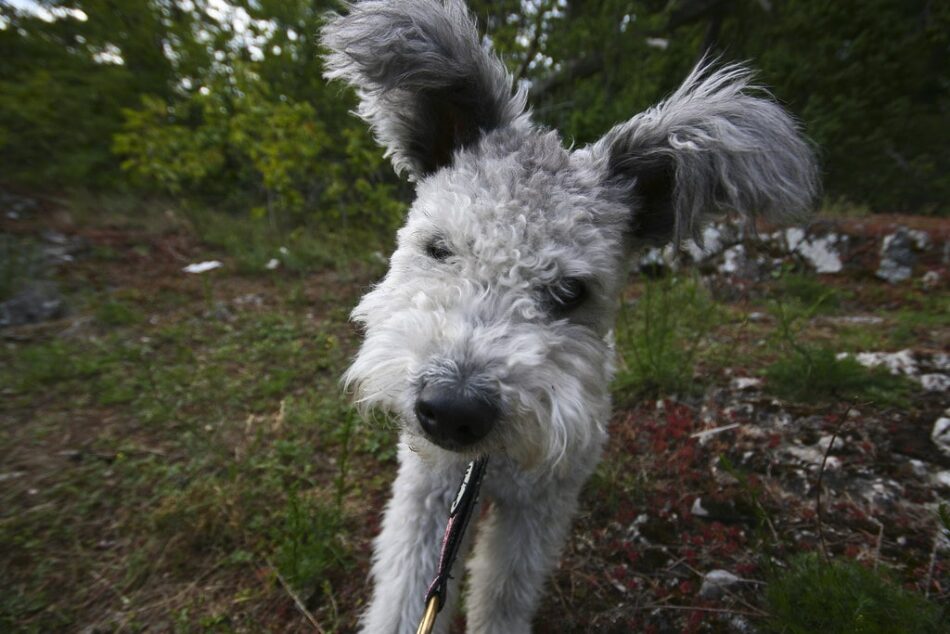
The Pumi is a result of selective breeding of the other famous Hungarian sheep dog, the Puli, and French and German herding dogs and terriers. This has given the breeds it’s lively, intelligent and active temperament.
Pumis love working, but also to relax with their family. It’s a generally happy breed that will make a great pet for an active family that can keep the dog busy during the day and shower it with love and snuggles on the sofa in the evening.
The curly coat, normally grey or black, requires a bit of work, but doesn’t shed.
This entry was posted in Dogs on May 6th, 2020 by linnearask
Are you thinking you might want to keep chickens and rabbits together? These two outdoor-loving pets actually share several similarities, and can live in harmony as long as their individual needs are met. Chickens and rabbits have shared barnyards across the world for generations, so with a little preparation and planning, you’ll be able to keep both in your backyard. Discover how to keep these two species together, and what to expect along the way.
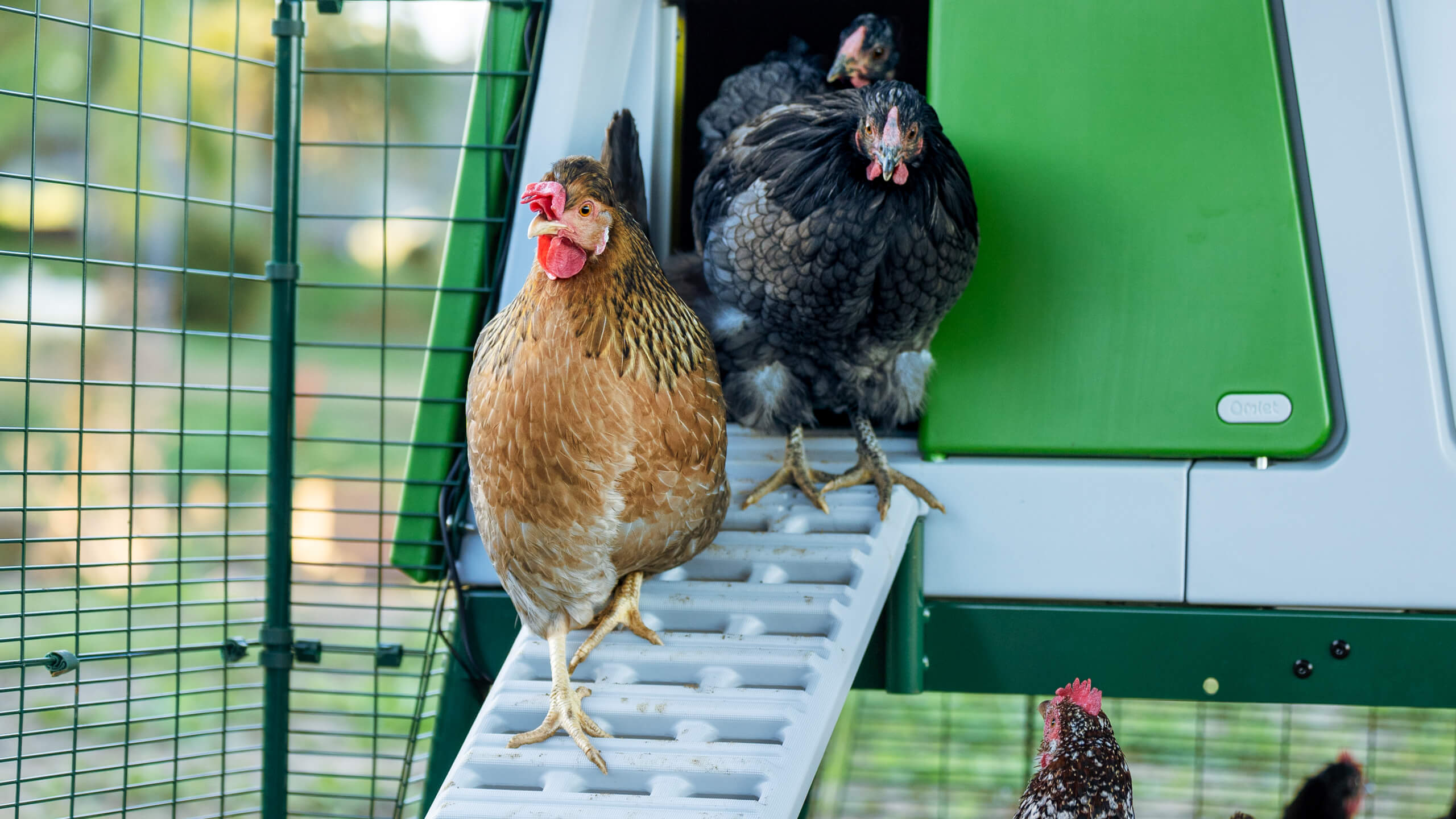
Chickens and rabbits together
Both chickens and rabbits are very social animals that enjoy spending time with others of their own kind, their owners, and even each other. Chickens and rabbits require about the same amount of space, and their ideal temperatures and the amount of care they require is similar. One large area with dedicated spaces for their own food and lodging is ideal for keeping fur and feathers together.
But there are a few things to think about if you’re considering keeping rabbits and chickens together – just putting them together in a chicken run or rabbit run without dedicated areas would be a mistake. We’ll share our top tips for how to help your flock and fluffle share a harmonious existence.
Introduce them early
You are more likely to succeed if you start introducing the animals to each other when they are young, so that they are raised together. But no matter which age they are, you’ll need to start by keeping them on different sides of a fence or a run so that they can get used to each other. Omlet’s partitions for the Outdoor Pet Run are perfect to create this separation. When they’re ready to spend time face-to-face, keep them in a very large enclosure, so that no one feels threatened by the other species. Make the enclosure gradually smaller, until they are all in the run where you are planning to keep them permanently.
Watch for signs of trouble
Your chickens might try to peck the rabbits while they are getting used to their fast movements. This doesn’t hurt a fully grown rabbit, and should pass after a few days. Never put a very young rabbit in with a flock of adult hens, as they are much more vulnerable. If your rabbit hasn’t been raised with the chickens from chicks, make sure your bunny is at least 4 or 5 months old before making introductions. If you notice tufts of fur being pulled out, or distress calls coming from your rabbit, remove them right away.
Different dwellings
Chickens and rabbits have very different sleeping habits. Chickens will roost overnight, while rabbits will seek shelter at ground level. Having their own sleeping quarters will also prevent chickens from depositing their droppings on unsuspecting rabbits during the night. Your chickens should have their own hen house, and bunnies should have a rabbit hutch to retire to at the end of the day, or when they’re overstimulated.
Dietary requirements
While chickens and rabbits can share fresh produce and certain treats, the bulk of their diet is very different. Chickens require layer feed, while rabbits need pellets that are lower in protein that are composed primarily of timothy hay. They’ll happily sample each other’s feed, but this can cause digestive upset. To prevent this, make sure your chicken feeders are out of reach of your rabbits, and that your rabbits are fed inside of their hutch, or in a separate area that they can access via Zippi Rabbit Tunnels, which are not accessible by most chickens.
Rabbits are tidy
Rabbits are well known for their cleanliness. They strive to eliminate in the same place each time, and they will meticulously clean themselves with their tongues and paws. Chickens on the other hand don’t maintain a reputation of tidiness. They’ll drop their eliminations wherever they are at the moment – which will not impress your rabbits. Thankfully, Omlet’s chicken coops, chicken runs, and rabbit hutches are all easy to clean, so you can keep their shared space tidy with minimal time and effort spent.
Make sure there’s room
Having two species in one place might be space efficient on the whole, but make sure the run is big enough and equipped with toys and hiding places to entertain and calm your pets. The Caddi Treat Holder is a perfect food toy for both rabbits and chickens to share fresh produce, and Zippi Play Tunnels are a perfect small den for a tired bunny.
Safety in numbers
Since chickens are flock animals, and rabbits live in groups, they need the company of the same species. Always keep at least two rabbits together – even if they’re with your chickens. Rabbits groom each other, sleep together, and speak the same language, so it’s important to have a pair of bunnies. Neutered males, spayed females, or one of each are usually the most successful pairings. Male rabbits kept together should always be neutered to avoid territorial displays, including those made toward your chickens. Similarly, roosters in a flock of chickens will defend the hens, which may mean displays of aggression toward rabbits. When keeping chickens and rabbits together, avoid having a rooster in the mix.
Omlet and your mixed flock
We’ve designed chicken coops and rabbit hutches to be not just practical and functional, but enjoyable. By combining your chickens and rabbits together in a shared space, you’ll be able to enjoy the company of each of them without sacrificing time with the other. In a large outdoor pet run, you can create the ultimate spot to spend time with your chickens and rabbits, and benefit from the interaction that different species have to offer each other – humans included.
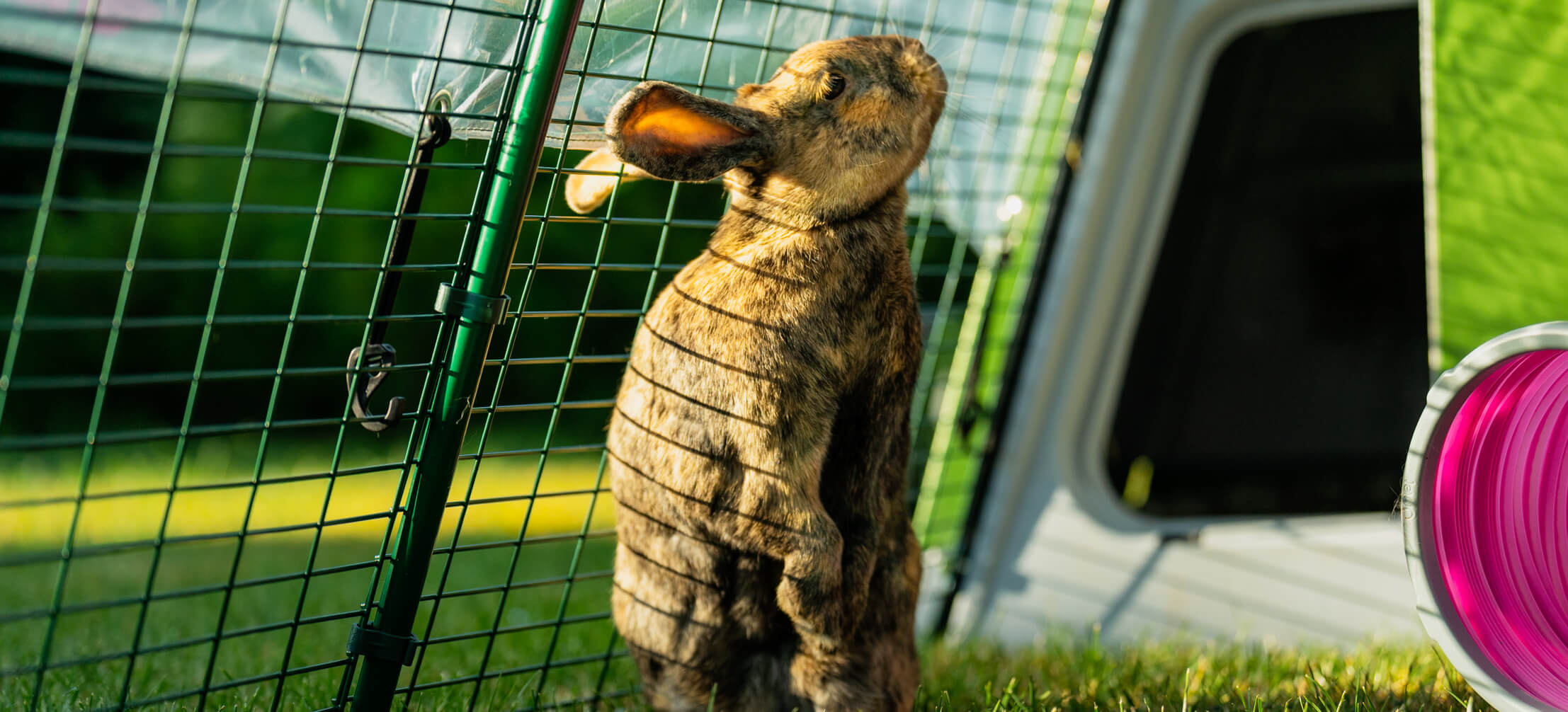

This entry was posted in Chickens on May 4th, 2020 by linnearask










 How to bring the outdoors indoors
How to bring the outdoors indoors

